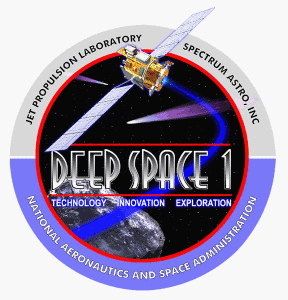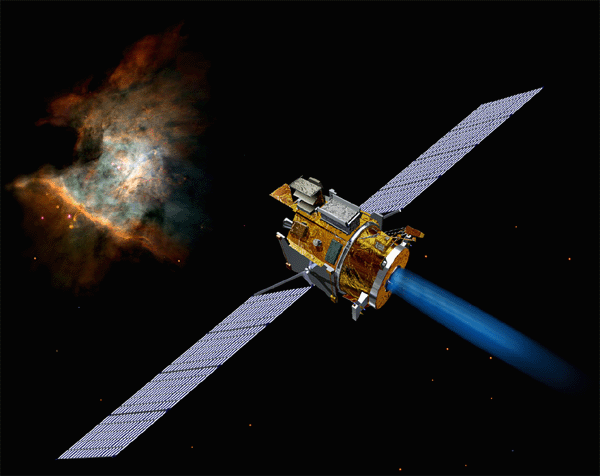






Selected Articles from the
October 1999 Odyssey
Editor: Craig E. Ward
NATIONAL SPACE SOCIETY
CHALLENGE and CALL FOR PAPERS
Editors Note: OASIS is a chapter of the National Space Society.
Is an economically self-sufficient space settlement feasible on the Moon or Mars or other bodies in the solar system?
NSS recognizes that the directions and timetable of human space settlement may very well depend on whether such settlement can be commercially profitable, or at least economically self-sufficient. To date, space activists have assumed that sooner or later such favorable economics would exist, but no one has set forth any scenario that would rigorously confirm such an assumption.
Accordingly, NSS is challenging the aerospace, economic and university communities to test the proposition of economic viability by making it the featured subject of a Special Call for Papers for its International Space Development Conference, to be held in Tucson over Memorial Day weekend, May 26-29, 2000.
"There is no question that private enterprise will play a major role in the development of the high frontier," said Lawrence D. Roberts, Chair of NSS's Policy Committee. "The papers presented will help to clarify the issues vital to such development, help formulate international and domestic space policy and enhance the prospects for commercial success."
THE CALL FOR PAPERS
National Space Society invites abstracts for Papers at its 19th Annual INTERNATIONAL SPACE DEVELOPMENT CONFERENCE on the subject of: An Economically Self-Sufficient Settlement on Another Body in the Solar System (e.g., the Moon, Mars, Asteroid or Comet). The Paper should describe a space settlement that is either:
- a "closed" system that, after start-up, is physically self-sufficient and thus able to function indefinitely without imports which would have to be paid for; or
- an "open" system that will require the import of resources and the means to generate income to pay for them. Ideally the space settlement should generate enough revenue to pay off all start-up costs (including, e.g., launch vehicles, transportation costs, settlement materials), but a Paper will be acceptable if it describes a settlement that is marginally profitable on an annual basis after writing off all start-up costs.
Papers should include technical, regulatory, economic and commercial assumptions, the anticipated stages of development, with timetables, and reasonably detailed projected income and expense statements validating the self-sufficiency in the relevant time periods.
The abstracts must be in English, must not exceed two 8-1/2 x 11 inch
pages (with 1 additional page of graphics if necessary), must summarize
a Paper suitable for presentation at the Conference, May 26-29, 2000,
in Tucson, AZ, and should estimate the length of the Paper. Those submitting
accepted abstracts will be invited to send the complete Papers for selection
and presentation. A Proceedings CD is anticipated. Three copies of each
abstract must be submitted. Abstracts should be submitted prior
to November 1, 1999, but may be accepted on a rolling basis through March
31, 2000. Mail to:
Abstracts
NSS 2000 ISDC
c/o Jeffrey Liss
180 N. LaSalle Street, Suite 2401
Chicago, IL 60601.
Early notification of intention to submit an abstract would be appreciated. E-mail inquiries should be sent to JGLJGL@aol.com.
READING BRAILLE
Part 1
By Robert Gounley
 It
takes teamwork to fly a spacecraft. I've had privilege to belong to such
teams at NASA's Jet
Propulsion Laboratory. Unlike the crew of the starship Enterprise,
we seldom encounter life-threatening adventures while exploring new worlds.
Mostly, we endure long hours of tedium punctuated by moments of excitement
- like feeling your stomach unknot when equipment millions of kilometers
away works as well as it did when you tested on the other side of the
room.
It
takes teamwork to fly a spacecraft. I've had privilege to belong to such
teams at NASA's Jet
Propulsion Laboratory. Unlike the crew of the starship Enterprise,
we seldom encounter life-threatening adventures while exploring new worlds.
Mostly, we endure long hours of tedium punctuated by moments of excitement
- like feeling your stomach unknot when equipment millions of kilometers
away works as well as it did when you tested on the other side of the
room.
However, sometimes the excitement can be completely different.
No one ever said that flying robotic spacecraft isn't rocket science. It requires a ground-based flight team to plan, test, and radio instructions to a computer onboard. There's little room for error, especially when the mission calls for flying past another body. Then the spacecraft, flying tens of kilometers per second, must sail past a planet or asteroid or comet, itself flying tens of kilometers per second in a different direction, at the precise moment when their crossed paths permit a friendly "hello." All the while, the spacecraft must capture once-in-a-lifetime pictures using a telephoto lens with a view narrow as a soda straw.
Ironically, encounters can be anticlimactic for the flight team. Beforehand, uncounted days, nights, and weekends have gone into preparations. By encounter day, virtually anything that could be done has been done. Now its time for the engineers to watch their spacecraft perform a graceful minuet designed to return a wealth of scientific data.
That is conventional wisdom. Deep Space 1 is an unconventional mission.
DS1, as we call it, was built to test fly new technologies for future deep space missions. No interplanetary spacecraft ever used ion propulsion, so DS1 is doing it. The same is true for concentrating solar array, autonomous navigation, and nine other engineering experiments. We built it quickly and inexpensively. When DS1 launched in October 1998, the small team that built and tested it handed over the keys to the even smaller team that would fly it.
We've learned a lot flying DS1. Not everything worked as expected, but we found ways to deal with the quirks. By summer 1999 planned testing was complete. There was only one item left for the prime mission - that was to fly past a small, near-Earth asteroid named 1992KD1 and collect scientific data.
An asteroid flyby isn't like testing an individual piece of spacecraft equipment. 1992KD1 is so small, at most a few kilometers wide, that DS1's cameras could not possibly discern much more than a speck except when very close. The only chance to capture high-resolution pictures last for only minutes on either side of DS1's closest approach to the asteroid. Then, it would be less than 15 kilometers away.
The asteroid, only visible through a handful of large Earth-based telescopes, was discovered in 1992. That's too little data to chart the orbit to the precision we required. The best we could do was to keep DS1 aimed for the center of a 1000 kilometer sphere where asteroid 1992KD1 would most probably be when DS1 passes by. Only when DS1's cameras detect its moving target, can the final course be set for rendezvous. At best, DS1's first detection of 1992KD1 might occur a few days before encounter.
Before this summer, we tended several different activities each week. Now everyone concentrated on a single, short command sequence to fly DS1 past the asteroid, take pictures, and transmit them back to Earth. Long design meetings each day were followed by long nights testing the changes that had just been made. Commands were added, rearranged, and deleted; with each new version the revision letter crept farther down the alphabet.
Months of preparation would have been normal. The team was doing the lion's share of the work in weeks.
All the while, DS1 kept coasting towards the asteroid. Periodically, we'd command a course correction, referred to as a trajectory correction maneuver or "TCM". Only a few brief pulses from the spacecraft's chemical thrusters were needed to keep it on target. That is, if we had accurately judged where the target would be.
 |
| Deep Space 1. NASA artwork |
My duties were to direct three TCMs scheduled for 48, 24, and 18 hours prior to closest approach. All of them would be preceded by an Optical Navigation activity (OPNAV). This routine turns DS1 so its camera can sight several large main-belt asteroids against a backdrop of known stars. These are DS1's landmarks to chart its way. Like a seafaring navigator with his sextant, DS1 automatically measures angles, computes its course, compares that course against its desired one, then determines the adjustments required. If allowed to do so, DS1 even performs the TCM by itself. This is the work of DS1's autonomous navigation system - another deep space first.
All this independent action comes with a price. Being a low-cost spacecraft, DS1 has only a high-gain antenna and it is bolted to one side. Whenever DS1 turns away from Earth, our flow of data slows to a trickle. We know little about what is happening until high-rate radio contact is regained at the end of each OPNAV or TCM. If something were going wrong, it could be hours before we'd know.
The autonomous navigation system worked well in flight test, but now the stakes were higher. By definitions set when the DS1 project started, our mission of testing technologies was complete. An asteroid flyby was a convenient final validation being done with far less preparation than conventional missions. Officially, we were doing a best effort encounter. Unofficially, we all knew that DS1 would be remembered by the asteroid pictures returned.
1992KD1 was a temporary name selected for the date of its discovery. When DS1 announced it would be flying past this undistinguished object, a scientific committee met to choose a permanent name from among hundreds of suggestions. A few days before encounter, a scientific committee released their decision. The asteroid would be called "Braille" after the inventor of printed material for the blind. The irony of this name was not lost on the flight team.
We hoped Braille might be visible before the 48 hour TCM. Indeed, OPNAV pictures showed an indistinct dot in about the right place that could possibly be Braille. No one felt comfortable with this identification. Once more we aimed DS1 for the center of the imaginary sphere where Braille should be. The TCM went flawlessly.
From the next OPNAV pictures, we saw that the suspicious dot had grown brighter. It was Braille! We sent DS1 messages to set course for its target. The 24-hour TCM went off without a hitch.
Post-TCM results encouraged us. From what we could see, DS1 was about as close to its target point as the most recent images could tell us. We'd have to wait until the spacecraft was closer before making finer, but necessary adjustments. We cancelled the 18-hour TCM and set our plans on what the next OPNAV would tell us. That information would go into the 12 hour TCM. After still more OPNAVs, DS1 would make its last corrections at 6 and 3 hours before closest approach.
That night, things could hardly look better. Having done my night's duties, I went home anticipating a quiet encounter day.
I was still thinking that when I arrived back at JPL early the next morning. There I saw several flight team members huddled over their monitors. Something had rebooted DS1's computer during the last OPNAV. Onboard recovery routines placed the spacecraft into a slow spin to await further instructions. The spacecraft was safe, but unprepared for the encounter.
Ready or not, DS1 would cross Braille's vicinity in less than 15 hours. There was a lot of work to be done.
TO BE CONTINUED...
Copyright © 1998-2003 Organization for the Advancement of Space Industrialization and Settlement. All Rights Reserved.